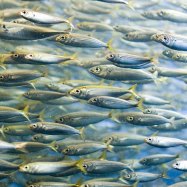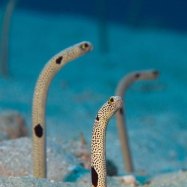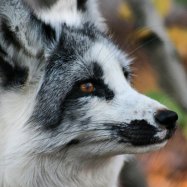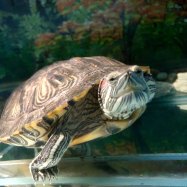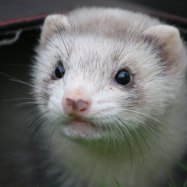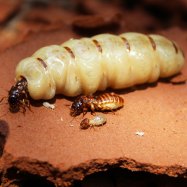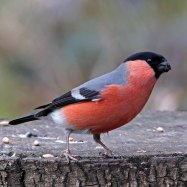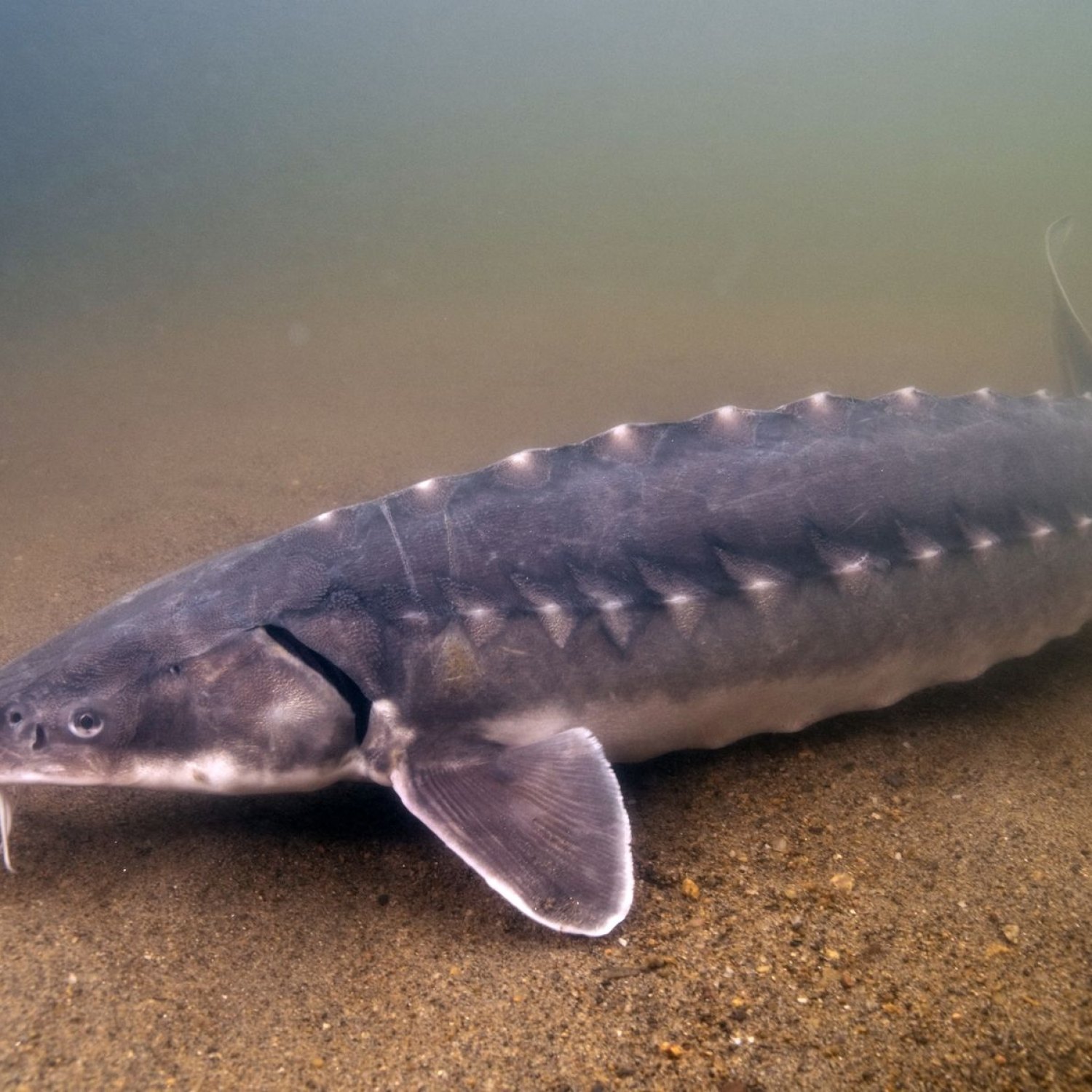
Sturgeon
Up to 18 feet
The Sturgeon is a massive fish species that can reach up to 18 feet in length. It can be found in various bodies of water such as rivers, lakes, and estuaries. This elongated and cylindrical-shaped animal belongs to the Acipenseridae family. These ancient fish are a sight to behold and are known for their unique appearance and behavior. Keep an eye out for these majestic creatures on your next water adventure! #Sturgeon #AquaticBeauty #RiverLife
Animal Details Summary:
Common Name: Sturgeon
Kingdom: Animalia
Habitat: Freshwater and coastal marine habitats
The Fascinating World of Sturgeons: Majestic Creatures of Freshwater and Coastal Habitats
Stepping into the enchanting world of sturgeons, one cannot help but be awestruck by the majestic creatures that inhabit the freshwater and coastal marine habitats. Known for their remarkable size, elongated and cylindrical body shape, and predatory feeding methods, sturgeons have captivated the imagination of humans for centuries. From their enormous size to their unique reproductive cycle, there is no doubt that sturgeons are one of the most fascinating creatures in the animal kingdom. So, let's dive deeper into the world of sturgeons and discover what makes them so captivating Sturgeon.The Basics: What is a Sturgeon?
Sturgeons belong to the family Acipenseridae, which is derived from the Greek words "acipenser" meaning sturgeon and "idae" meaning descendants. Their scientific name, Acipenseridae, may be a tongue-twister to pronounce, but it simply translates to "sturgeon family." Sturgeons are a type of bony fish, belonging to the class Actinopterygii, which means they have fins supported by bony rays. They are also part of the order Acipenseriformes, which includes other primitive fish such as paddlefish.Sturgeons are typically found in freshwater and coastal habitats in Europe, Asia, and North America, making them widely distributed across the globe. These magnificent creatures can be found in various countries, including Russia, China, and the United States. They are most commonly found in rivers, lakes, and estuaries, where they can easily hunt and find food.
The Appearance: Not Your Ordinary Fish
One look at a sturgeon, and it's clear that this is not your ordinary fish. Their elongated and cylindrical body shape, paired with their enormous size, sets them apart from other fish species Sealyham Terrier. Sturgeons can reach lengths of up to 18 feet and weigh up to a whopping 1,500 pounds. This makes them one of the largest freshwater fish in the world.Their distinctive coloration is another aspect that sets sturgeons apart from other fish. Most sturgeon species have a gray or brown coloration, which helps them blend in with the sandy or rocky bottom of the water bodies they inhabit. This natural camouflage allows them to easily hide from predators and ambush their prey.
The Life of a Sturgeon: Fascinating Facts
One of the most intriguing aspects of sturgeons is their unique life cycle and reproductive habits. Unlike most fish that spawn and die, sturgeons can live for over 100 years, with some species living up to 150 years. This makes them one of the longest-living fish species on the planet.Moreover, sturgeons have a unique reproductive cycle, known as anadromy. This means that they are born in freshwater, migrate to the ocean to grow and mature, and then return to freshwater to reproduce. This remarkable journey can take several years, with some sturgeons traveling thousands of miles in their lifetime. During their migration, sturgeons face numerous challenges, such as dams, pollution, and overfishing, which have led to a decline in their population.
The Predator: How Sturgeons Hunt for Food
Sturgeons are known for their predatory feeding methods, with their sharp, toothless mouths designed for catching and consuming their prey. They are bottom feeders, meaning they forage for food on the river or lake bed, using their barbels (whisker-like organs) to sense and find their prey.Their diet primarily consists of small fish, crustaceans, and other water-dwelling creatures. However, sturgeons have also been known to consume plant matter and have even been observed feeding on small mammals and birds. With their massive size and powerful jaws, sturgeons have no trouble catching and devouring their prey.
The Threats: Conservation Efforts for the Survival of Sturgeons
Despite their reputation as sturdy and resilient creatures, sturgeons are facing numerous threats to their survival. One of the main reasons for the decline in sturgeon populations is overfishing. Sturgeons are highly prized for their caviar, which is eggs from the females that are processed into a luxury food product. This has led to excessive fishing and poaching, resulting in a significant decline in sturgeon numbers.Moreover, the construction of dams and pollution in their habitats has also affected sturgeons' ability to migrate and reproduce successfully. These barriers, both natural and man-made, have disrupted their natural life cycle and prevented them from reaching their spawning grounds.
The Future: What Can Be Done to Protect Sturgeons?
To ensure the survival of sturgeons, conservation efforts are underway worldwide. Various initiatives, such as breeding programs, have been established to help replenish sturgeon populations. However, these efforts are often challenging and time-consuming, as sturgeons have a slow growth rate and require specific conditions to reproduce successfully.To address the issue of overfishing, many countries have put in place strict laws and regulations to limit the catch of sturgeons. Some countries have even banned commercial fishing of sturgeon altogether to allow their populations to recover.
Additionally, efforts are being made to protect sturgeon habitats by implementing conservation measures such as cleanup efforts and the construction of fish ladders. These initiatives provide safe passageways for migrating sturgeons, allowing them to reach their spawning grounds and continue their life cycle.
The Appeal: Sturgeons in Culture and Cuisine
Sturgeons have long captured the imagination of humans, and their cultural significance is undeniable. In ancient mythology, sturgeons were viewed as symbols of power, longevity, and prosperity. They were also considered sacred among some Native American tribes, who believed that they brought good luck and abundance.Moreover, sturgeons have long been prized for their caviar, a luxury food item often associated with fine dining and indulgence. Caviar has been consumed for centuries, with its origins dating back to the Byzantine Empire and ancient Persia. Today, caviar is a highly sought-after delicacy, with the global caviar market expected to reach over $560 million by 2025.
The Connection: How Sturgeons Impact Ecosystems
The decline in sturgeon populations has a ripple effect on their habitats and ecosystems. Sturgeons play an essential role in maintaining the health of their habitats by foraging on bottom-dwelling creatures, preventing overpopulation. They also act as prey for larger predatory fish, contributing to the balance of the food chain.Moreover, sturgeons' migratory behavior and spawning habits also have a significant impact on the rivers they inhabit. As they travel to and from the ocean, they transport important nutrients and sediments, which can benefit the overall ecosystem and support other species.
The Conclusion: Appreciating the Majestic Sturgeon
In conclusion, sturgeons are undoubtedly among the most magnificent creatures in the animal kingdom. Their enormous size, unique life cycle, and predatory feeding methods make them stand out from other fish species. However, sturgeons are facing numerous threats to their survival, and it is up to us to protect them.Through conservation efforts and sustainable fishing practices, we can ensure that sturgeons continue to thrive in their natural habitats. By appreciating and understanding the significance of sturgeons, we can also play a role in preserving these majestic creatures for future generations to admire. So, the next time you spot a sturgeon in the wild or enjoy a serving of caviar, remember the fascinating world of sturgeons and the importance of protecting these majestic creatures.

Sturgeon
Animal Details Sturgeon - Scientific Name: Acipenseridae
- Category: Animals S
- Scientific Name: Acipenseridae
- Common Name: Sturgeon
- Kingdom: Animalia
- Phylum: Chordata
- Class: Actinopterygii
- Order: Acipenseriformes
- Family: Acipenseridae
- Habitat: Freshwater and coastal marine habitats
- Feeding Method: Predatory
- Geographical Distribution: Europe, Asia, and North America
- Country of Origin: Various countries
- Location: Rivers, lakes, and estuaries
- Animal Coloration: Gray or brown
- Body Shape: Elongated and cylindrical
- Length: Up to 18 feet
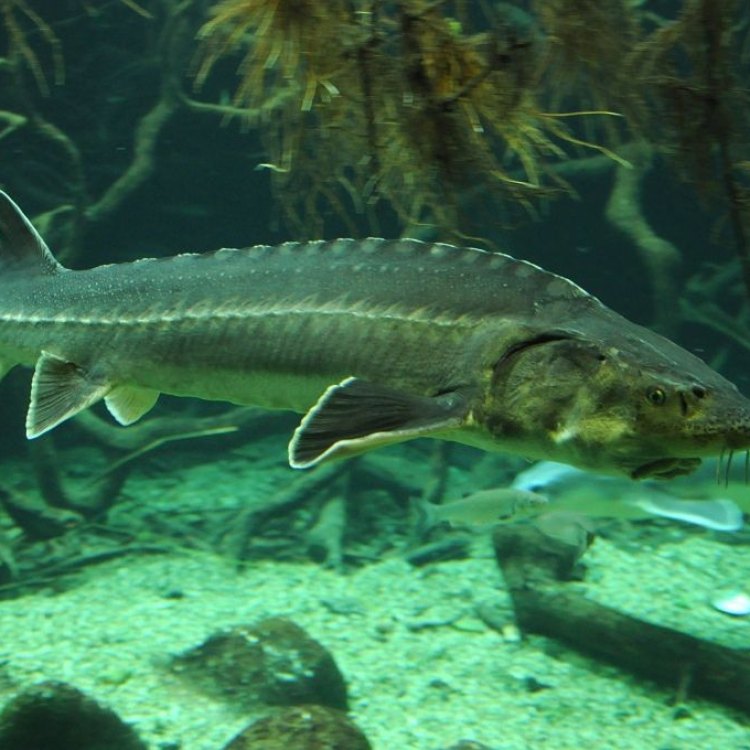
Sturgeon
- Adult Size: Varies by species
- Average Lifespan: Up to 100 years
- Reproduction: Oviparous
- Reproductive Behavior: Migratory to spawning grounds
- Sound or Call: No
- Migration Pattern: Migratory
- Social Groups: Solitary
- Behavior: Bottom-dwelling and slow-swimming
- Threats: Overfishing, habitat destruction, pollution
- Conservation Status: Varies by species, some are critically endangered
- Impact on Ecosystem: Key species in freshwater ecosystems
- Human Use: Fishing, caviar production
- Distinctive Features: Bony plates called scutes, long snout
- Interesting Facts: Sturgeons are considered living fossils, having existed for over 200 million years. They are also known for their valuable roe, which is made into caviar.
- Predator: Humans, large predatory fish
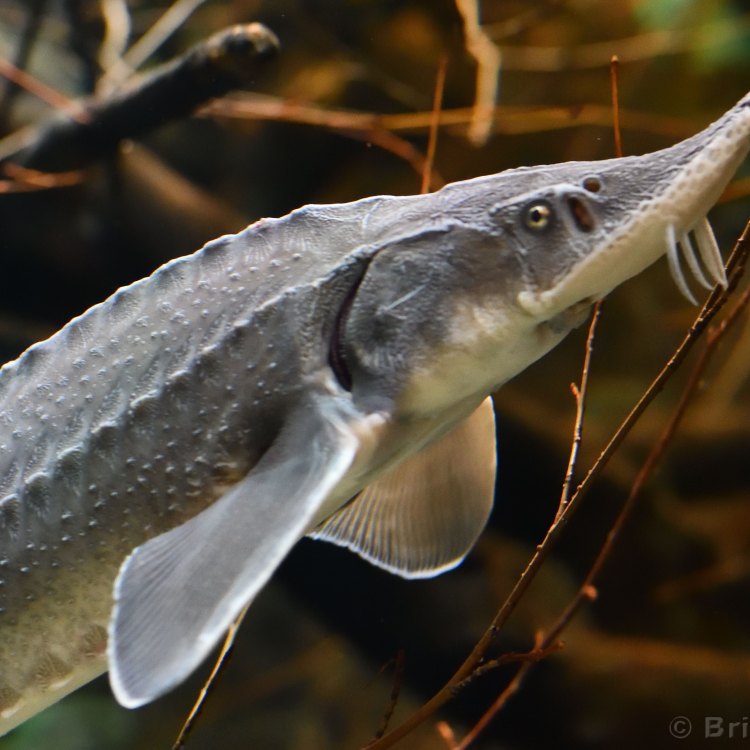
Acipenseridae
The Amazing Sturgeon: A Living Fossil of the Aquatic World
When you think of marine animals, you probably picture colorful fish swimming in the vibrant coral reefs or majestic whales breaching in the open ocean. But hidden in the depths of freshwater bodies all around the world lives a remarkable creature, one that is often overlooked and underappreciated - the sturgeon.Sturgeons belong to the family Acipenseridae, and there are 27 different species distributed in rivers and lakes of Europe, Asia, and North America. These ancient fish are truly one of a kind, with a set of unique features and behaviors that make them stand out in the underwater world PeaceOfAnimals.Com.
Size and Lifespan
One of the most remarkable traits of sturgeons is their impressive size. Depending on the species, they can range from a mere 2 feet to a whopping 18 feet in length. The largest recorded sturgeon was a Beluga sturgeon weighing over a ton and measuring 24 feet long!But what's even more astonishing is their lifespan. Sturgeons are known to be one of the longest-living vertebrates on the planet, with some species living up to 100 years. Imagine being able to swim in the same waters for a century! This impressive lifespan is thanks to their slow growth rate and late sexual maturity, making them vulnerable to threats such as overfishing and habitat destruction.
Reproduction and Behavior
Sturgeons are oviparous, which means they lay eggs. They have a unique reproductive behavior where they migrate to specific spawning grounds to lay their eggs. These spawning grounds are usually in rivers or shallow waters, making it easier for the newly hatched fry to survive.What's even more fascinating is that sturgeons are migratory fish, meaning they travel long distances to reach their spawning grounds Stag Beetle. They have the ability to travel hundreds of miles, facing obstacles such as dams and barriers along the way. This behavior makes them critical in maintaining the balance of ecosystems as they transport numerous nutrients and energy from one location to another.
Social Structure and Behavior
Sturgeons are solitary creatures and are mostly found living alone in deep, slow-moving waters. They are bottom-dwellers, meaning they spend most of their time near the river or lake floor, using their elongated snout to stir up sediment in search of food. They are also slow-swimmers and have a unique ability to change their swim bladder's buoyancy, allowing them to hover above the riverbed as they search for food.This slow lifestyle, combined with their long lifespan, has made sturgeons vulnerable to overfishing. They are often caught as bycatch or targeted for their valuable roe, which is considered a delicacy in many cultures.
Threats and Conservation Status
Sturgeons face numerous threats, including overfishing, habitat destruction, and pollution. Due to their slow growth rate, it takes years for sturgeon populations to recover from overfishing. The black market for caviar has also contributed to the decline of sturgeon populations, leading some species to become critically endangered.Thankfully, many efforts are being made to conserve these unique creatures. Several countries have established protected areas where sturgeon populations can breed and thrive safely. Additionally, stricter regulations and sustainable fishing practices have been implemented to reduce the impact of overfishing.
Impact on Ecosystems
Sturgeons are considered a key species in freshwater ecosystems. As bottom-dwellers, they play a crucial role in regulating nutrient distribution, which helps maintain the balance of the aquatic food web. They also help to aerate the sediment, creating healthier habitats for other aquatic species. Therefore, the decline of sturgeons can have far-reaching consequences, impacting not only the sturgeon population but also the entire aquatic ecosystem they are a part of.The Human Use of Sturgeons
Sturgeons have played an essential role in human history and culture. They have been hunted and used as a source of food and raw materials for centuries. However, with the rise of caviar's value, sturgeons have been heavily exploited, leading to a decline in their populations.Today, sturgeons are primarily used for their roe, which is processed into caviar, a luxury food item. The production of caviar is a lucrative industry, with prices reaching up to $35,000 per kilogram. However, due to the significant decline in sturgeon populations, caviar production has become heavily regulated to ensure sustainable practices.
Distinctive Features
Sturgeons have several remarkable features that set them apart from other fish in the aquatic world. One of their most notable qualities is their bony armor, consisting of large, overlapping plates called scutes. These scutes protect them from predators, but unfortunately, they are no match for humans' advanced hunting techniques.Sturgeons also have a long, pointed snout that they use to detect food buried in the sediment. Their unique snout, combined with their ability to change their swim bladder's buoyancy, allows them to navigate through murky waters with precision.
Interesting Facts
Sturgeons are considered living fossils, having been around for over 200 million years. They shared the same waters as dinosaurs and have witnessed the Earth's transformations throughout history. This evolutionary success is partly due to their unique adaptations, making them one of the most resilient species in the aquatic world.Another fun fact about sturgeons is that they outlived their predators. Sharks, who were once the top predators in the ocean, have been around for about 400 million years, but sturgeon has been around for over half of that time.
Predators
Despite their longevity, sturgeons still face threats from predators. However, the most significant threat to their survival is us - humans. Overfishing, habitat destruction, and pollution have caused a significant decline in sturgeon populations worldwide. Large predatory fish, such as sharks, also pose a threat to sturgeons, especially the juveniles.In Conclusion
Sturgeons are truly remarkable creatures, with a set of unique features and behaviors that make them one of a kind. Sadly, their populations are declining, and they face numerous threats in their natural habitats. It is up to us, as responsible inhabitants of this planet, to protect and conserve these living fossils for generations to come.Next time you come across a sturgeon, take a moment to appreciate its ancient beauty and the essential role it plays in maintaining the balance of freshwater ecosystems. Let's work together to ensure that these remarkable creatures continue to thrive in our waters for years to come.
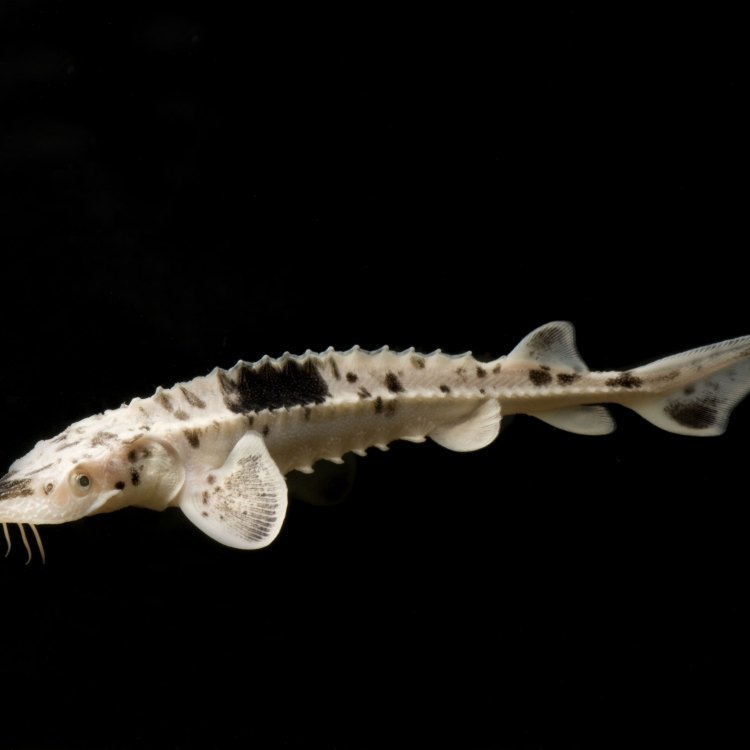
The Fascinating World of Sturgeons: Majestic Creatures of Freshwater and Coastal Habitats
Disclaimer: The content provided is for informational purposes only. We cannot guarantee the accuracy of the information on this page 100%. All information provided here may change without prior notice.


